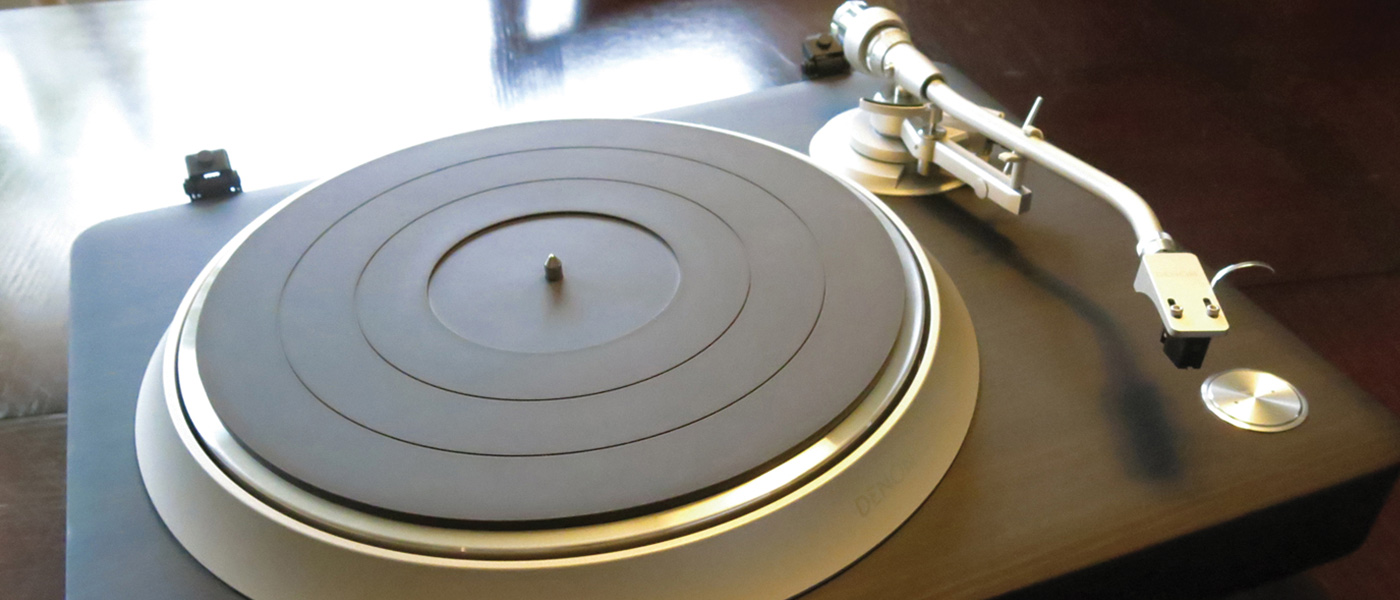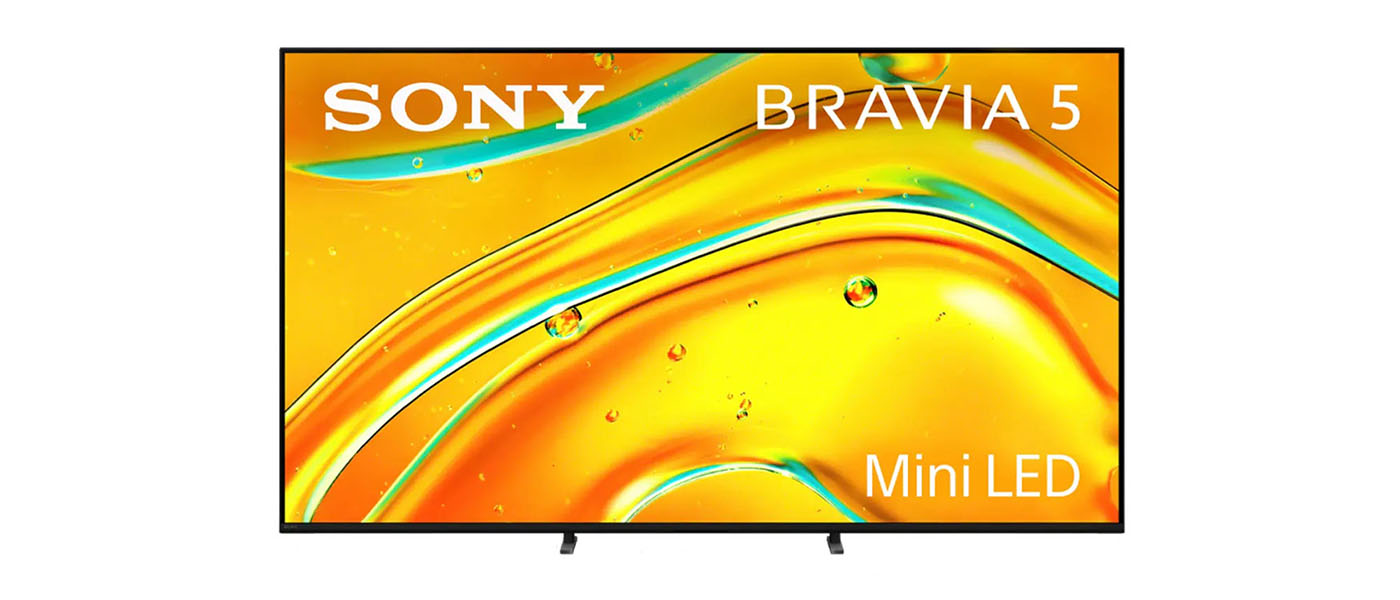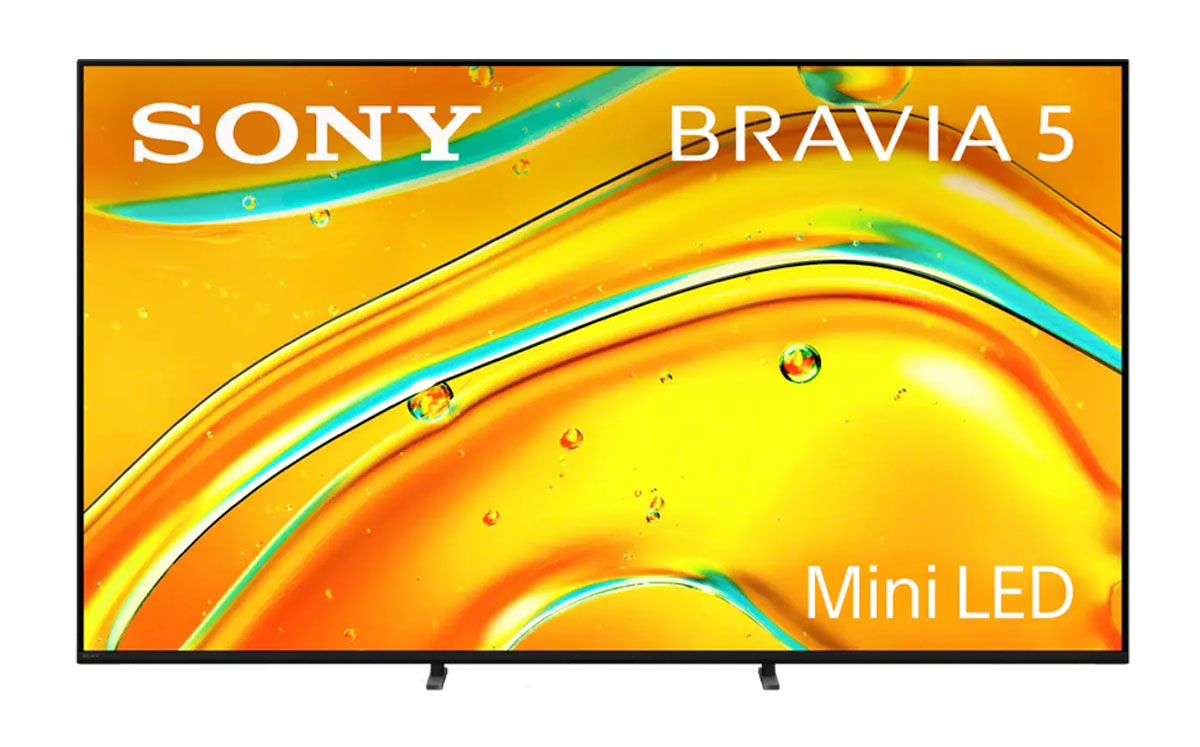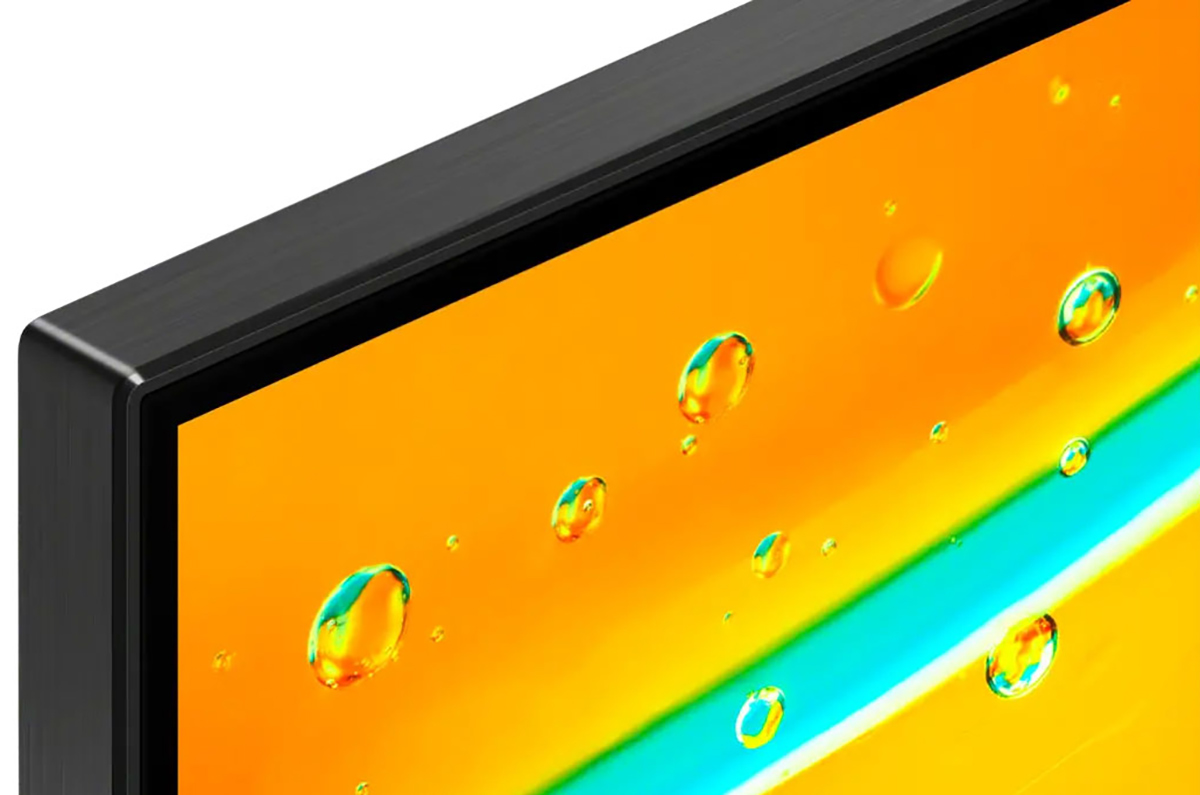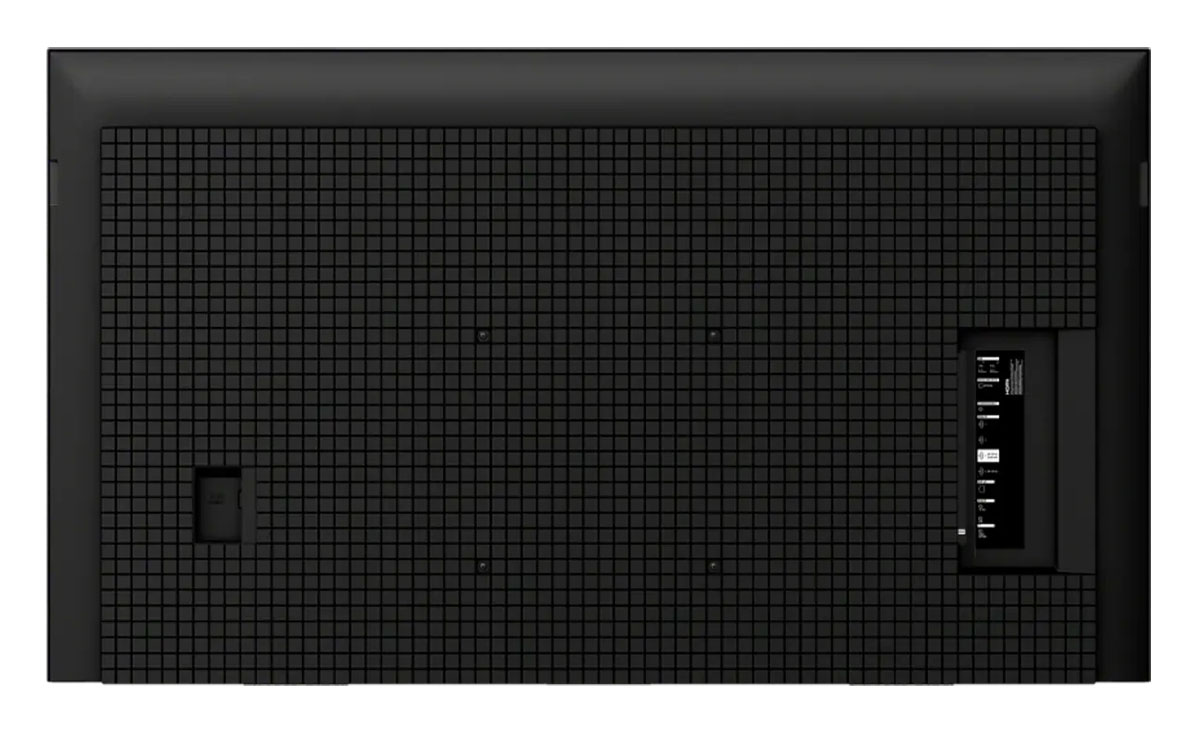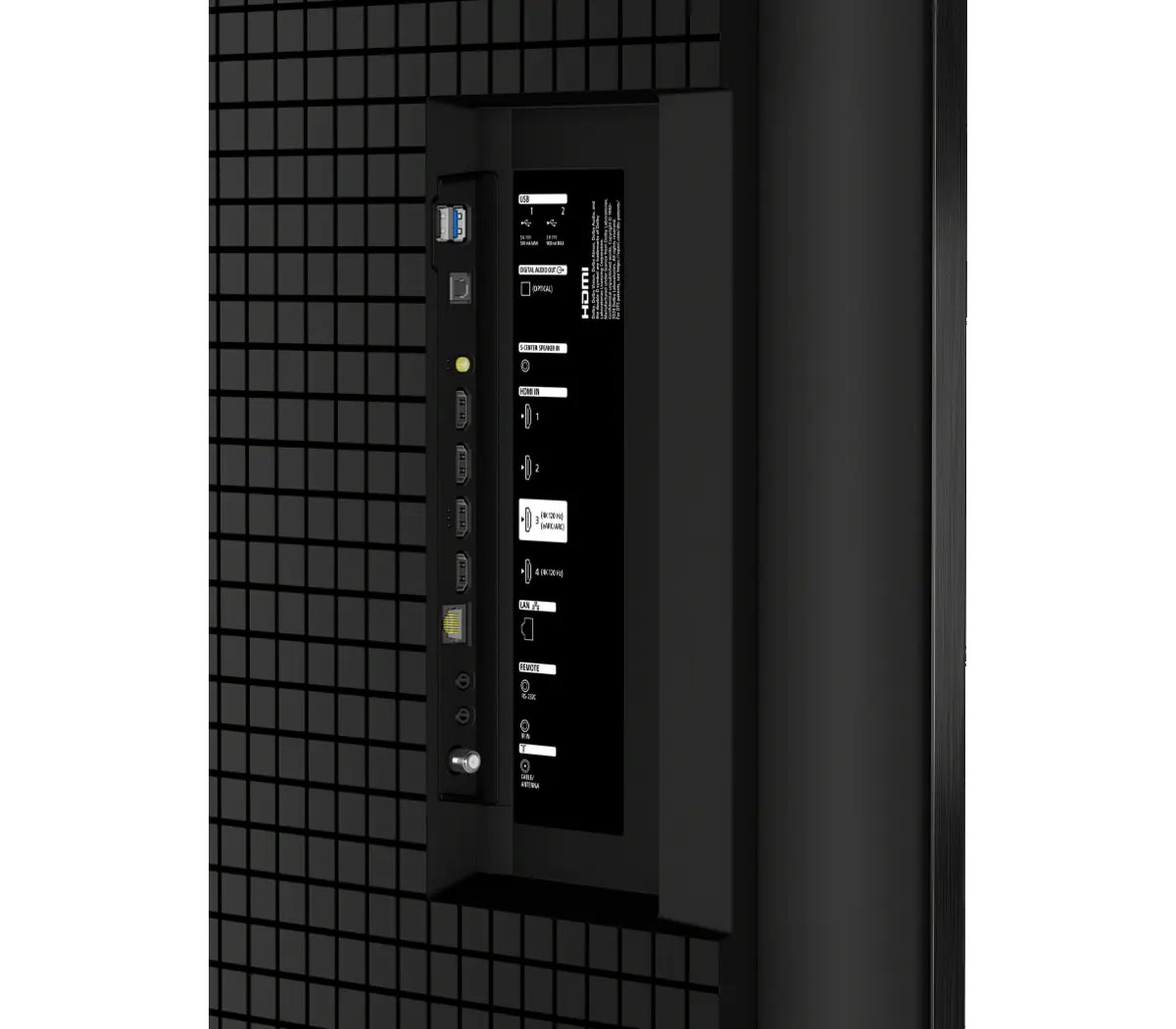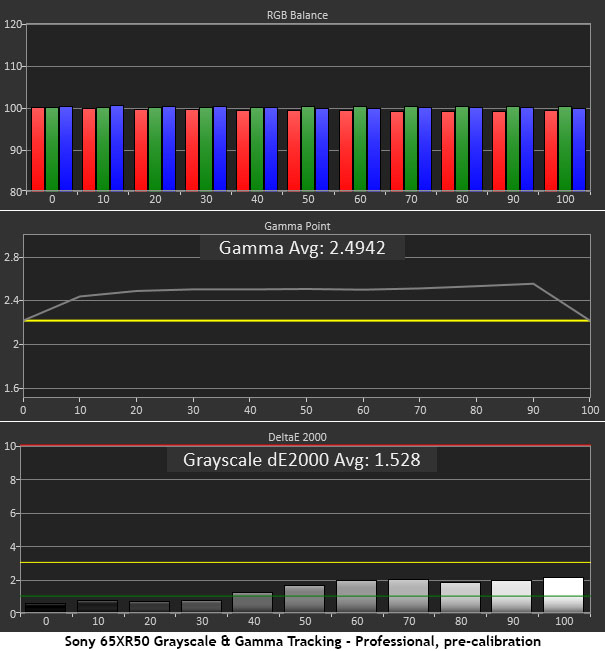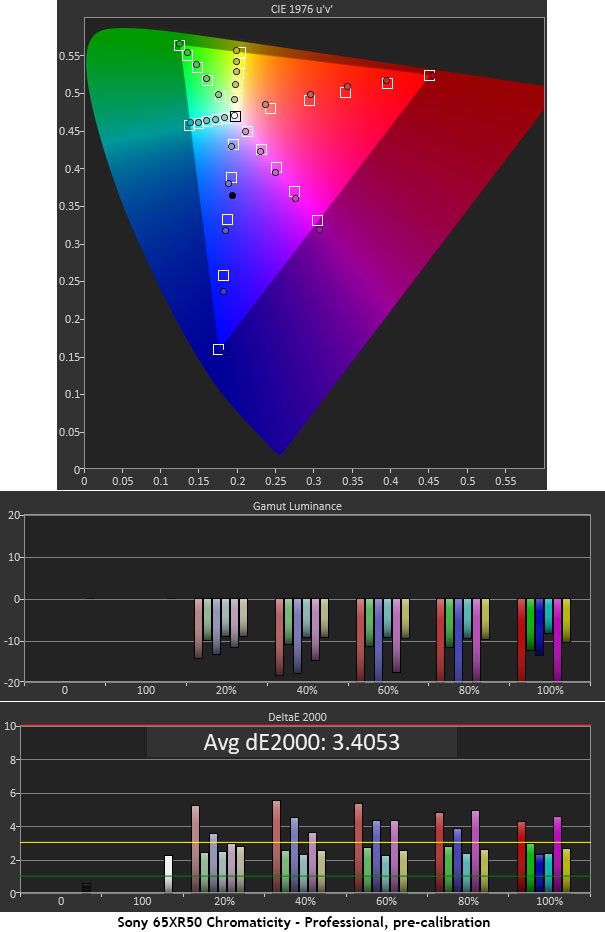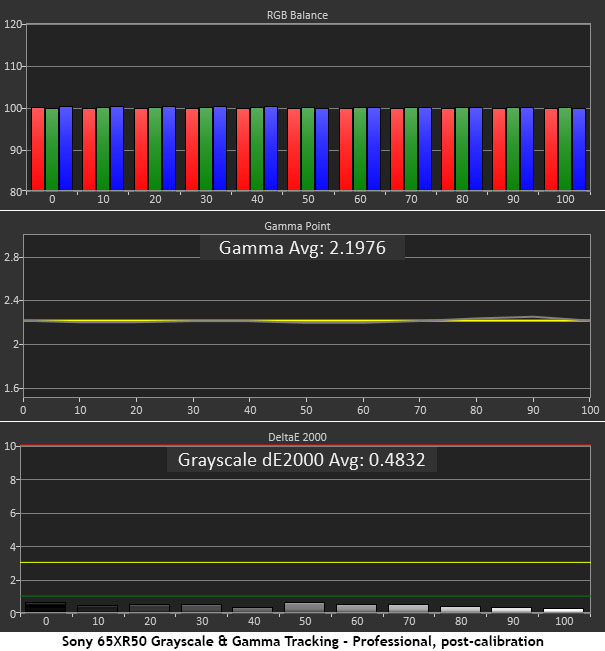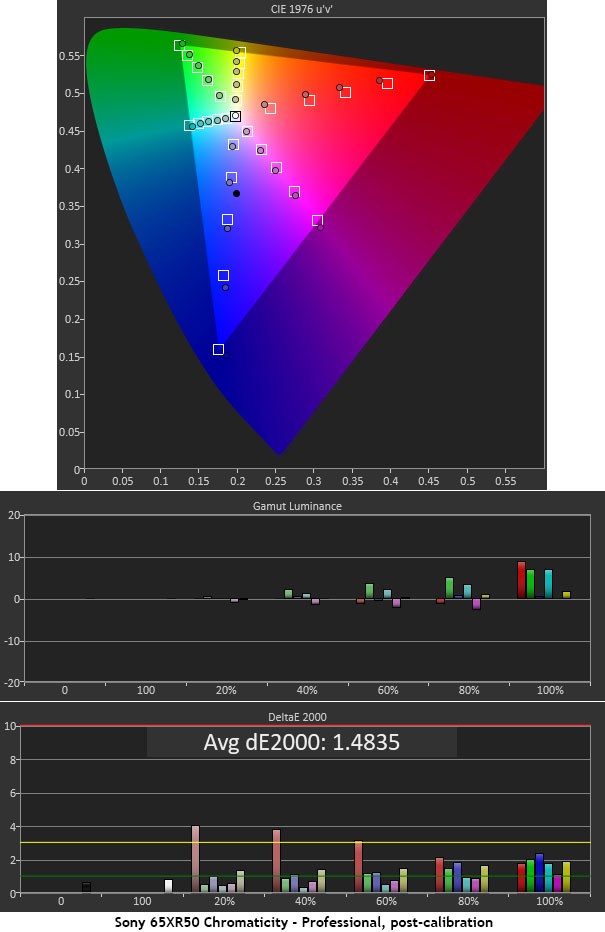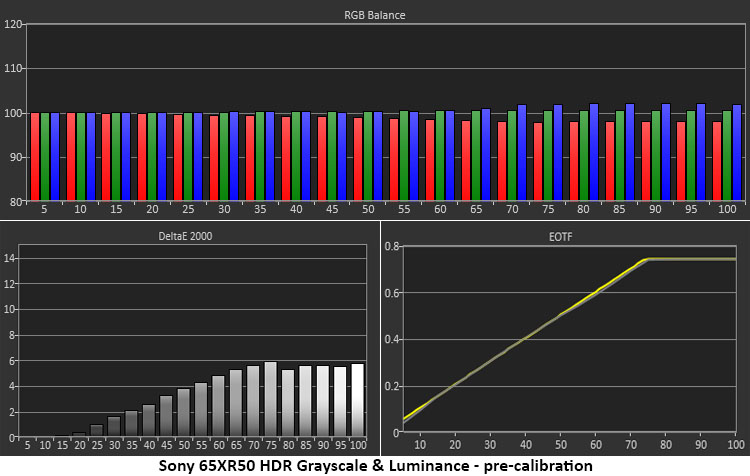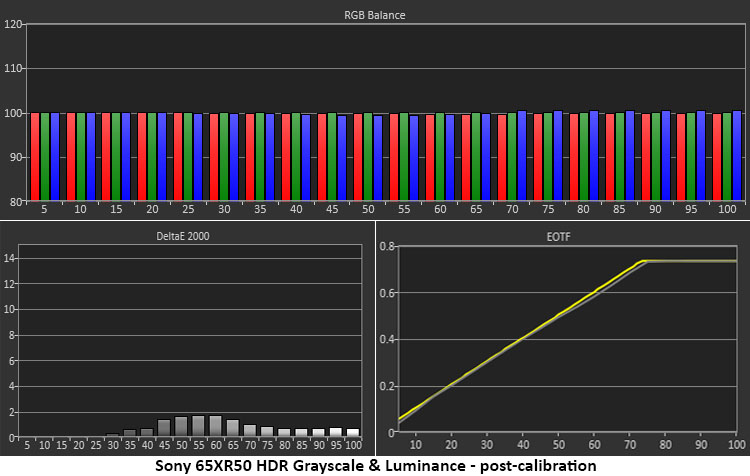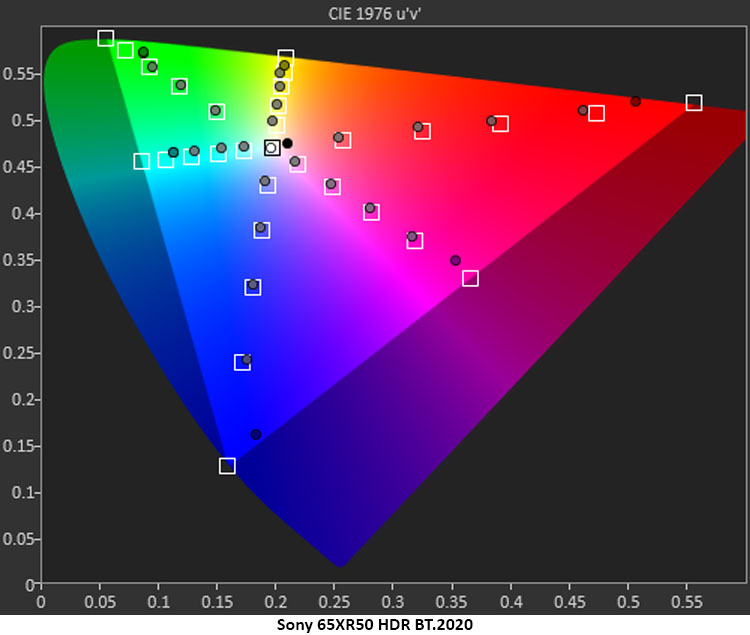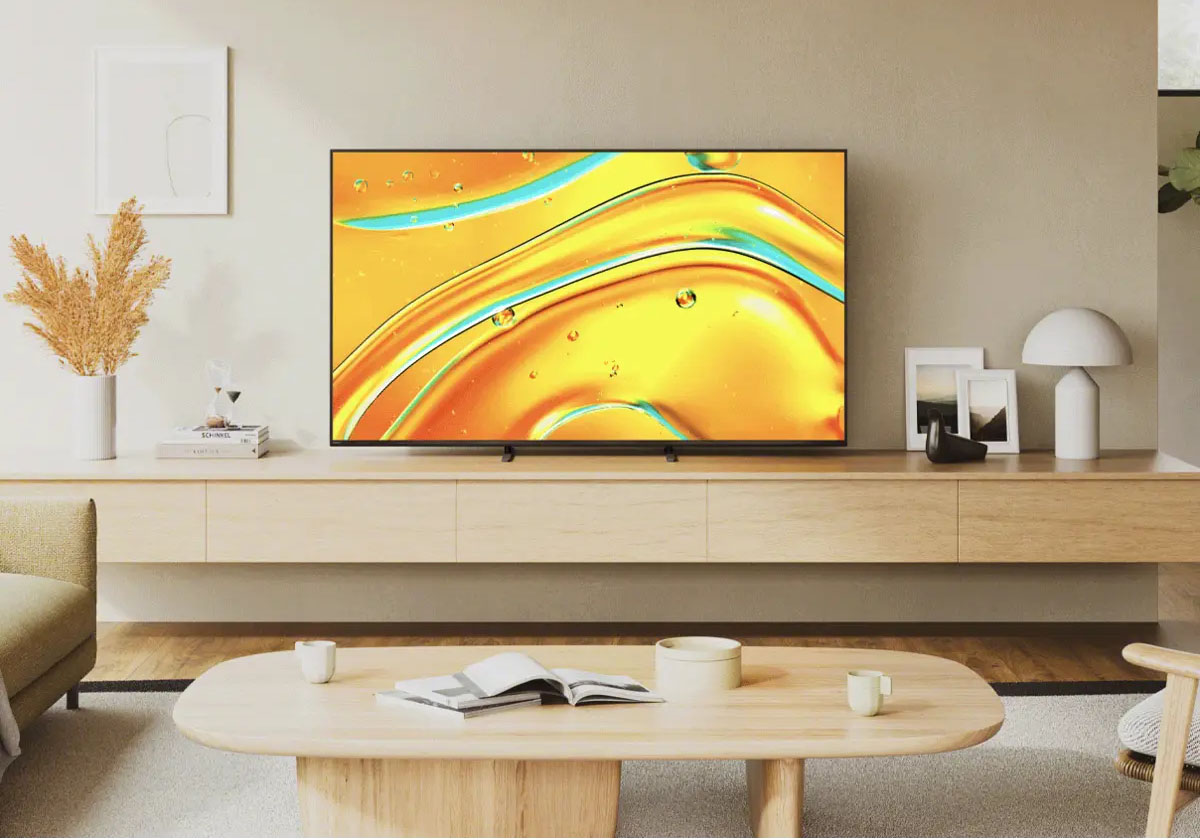Sony delivers excellent value and high performance from its BRAVIA 5 65XR50. It’s a 65-inch Mini LED TV with a high-contrast VA panel. It offers Ultra HD resolution, wide-gamut color, zone dimming, HDR, HLG, Dolby Vision, and 120 Hz VRR support for gaming. Accurate color modes eliminate the need for calibration. You also get decent built-in audio and easy integration with sound bars through HDMI eARC. Google TV brings thousands of content providers into your living room over Wi-Fi.
Sony BRAVIA 5 65XR50 65-inch Mini LED TV
- 65-inch Mini LED VA panel with 3840 x 2160 resolution
- 384 dynamic dimming zones
- HDR10, HLG, and Dolby Vision support
- Wide gamut color with 95% coverage of DCI-P3
- Accurate color modes included
- IMAX Enhanced mode
- 120 Hz with VRR for gaming
- Four HDMI inputs, including one with eARC for easy sound bar integration
- Excellent value at $1,500 MSRP
Easily the best bang-for-the-buck HDTV these days is a Mini LED. A 65-inch Vertical Alignment (VA) panel with Ultra HD resolution, wide gamut color, HDR, and 120 Hz VRR can be had for well under $2,000. Sony has just the thing in its stable with the BRAVIA 5 65XR50 selling for $1,500 at this writing. Its Mini LED zone dimming backlight can top 1,000 nits when showing HDR content, and that format is supported in HDR10, HLG, and Dolby Vision variants. HDR10 and HLG get a dynamic tone mapping option as well. There is a myriad of picture enhancements that smooth out motion, increase contrast, and make the picture super sharp. It includes decent built-in speakers, or you can integrate a sound bar through the HDMI eARC port and control everything from a single remote. Google TV ensures that you’ll never be wanting for something to watch. It brings streams from thousands of carriers, and the most popular ones even get their own dedicated buttons on the remote, which can be voice-controlled. It’s a very impressive package that deserves a closer look.
Panel:
65-inch Vertical Alignment (VA) LCD
Resolution and Aspect ratio:
3840 x 2560 pixels 16:9 (1.78:1)
Refresh rate:
120Hz, VRR support
Backlight:
Mini LED, 384 dimming zones
Audio:
20 watts x 4 speakers, Dolby Atmos, DTS:X
Video inputs:
2x HDMI 2.1 (1x w/eARC), 2x HDMI 2.0, antenna
Audio:
optical out, 3.5mm (Sony sound bars and AVRs only)
Data inputs:
2x USB, Wi-Fi 6 (802.11ax), RJ45
Control:
RS-232, IR
Dimensions w/stand (W x H x D):
57” x 35.88” x 13.63”
Weight:
58 pounds
Price:
$1,499.99
Warranty:
One year
Website:
Company:
SECRETS Tags:
sony, bravia 5, 65xr50, ultra hd tv, hdtv, hdr, dolby vision, 65 inch tv, mini led tv
- Epson QL7000 4K HDR High-Lumen 3LCD Laser Projector Review
- GOOVIS G3 Max 3D Head Mounted Display Review
Secrets Sponsor
The 65XR50 uses a VA panel, which is currently the LCD variant with the highest native contrast. In testing, I measured over 4,500:1 before any dynamic options were engaged. The Mini LED backlight delivers both high brightness and extra contrast through local dimming. There are 384 zones, which isn’t a huge number for a panel this size. But I found the halo effects to be minimal thanks to Sony’s solid image processing.
There is no Quantum Dot color here, which helps keep the price down, but the 65XR50 covers around 95% of DCI-P3, making it very colorful indeed. It correctly renders BT.709 for SDR content and switches automatically to its full native gamut in HDR mode. If you prefer full color for all content, that option is available. HDR is supported in HDR10, HLG, and Dolby Vision formats. The first two get an excellent dynamic tone mapping option. You also get zone dimming and other dynamic options that increase dynamic range to nearly 20,000:1.
From the front, the 65XR50 is all screen with a slim 9mm flush bezel around the top and sides. From a normal viewing distance, you can’t even see the frame. The bottom trim is about an inch wide. The stand is two legs that slip into dedicated slots on the bottom. It can sit right on the furniture surface or raise up enough to accommodate a sound bar. The panel sides are finished in a brushed metal texture, black, of course. A 300mm VESA mount pattern accommodates wall mounting brackets, which are not included.
Audio is given a lot of attention here, and you can get decent sound without an external solution. Codecs up to Dolby Atmos and DTS:X are supported along with IMAX Enhanced. Special processing does a fair job at simulating surround sound, and there is decent bass. Dialog enhancement uses AI to put voices forward in the mix.
Like many TVs today, the 65XR50 is a smart display powered by Google TV. This familiar interface extends to the menu system, which makes it much like other TV and projector brands in look and feel. Sony takes it further with special picture modes for Netflix and Prime Video. You also get Chromecast, AirPlay 2, Google Assistant, and Alexa.
The input panel is on the back left side, recessed for easy cable management. You get four HDMI inputs, two 2.1 and two 2.0, and one of them supports eARC. I used this for a Sony sound bar, the BRAVIA Theater Bar 6 ($650), which I’ll cover in a separate review. Remaining connections include antenna for the internal QAM tuner, optical audio out, a 3.5mm audio out for Sony sound bars and ARVs, and control via IR and RS-232. Two USBs support data and power. Networking is via Wi-Fi or RJ45.
The remote is a small handset with all the buttons you’ll need to control the 65XR50 and its streaming interface. It is not backlit. It includes dedicated keys for Netflix, Prime Video, Sony Pictures Core, Disney+, YouTube, and Crunchyroll. An integrated microphone supports Google Assistant and Alexa.
After inserting the stand legs in the bottom of the 65XR50, I set it up on a table in my theater along with a BRAVIA Theater Bar 6, which I connected to the eARC port. Selecting external audio from the TV’s menu sent the sound to the bar, which I had already configured with my phone using Sony’s BRAVIA Connect app. It ran me through a short measurement routine that I’ll detail in my review of the sound bar.
The 65XR50’s menu system is a mix of Sony and Google TV elements, but it was very familiar and easy to navigate. The first step is to connect to Wi-Fi, which I did in seconds. Logging into my Google account gave me instant access to the usual list of streaming providers.
The 65XR50 has seven SDR picture modes, each with an HDR10 counterpart. Dolby Vision has three of its own modes. For SDR, I chose Professional as the starting point. Initial measurements showed it only needed a gamma adjustment. The picture looked too dark, even after turning up the brightness. No wonder, as it was tracking a gamma value of 2.5! A few tweaks took me to reference level. The color gamut renders BT.709 for SDR when that option is set to auto. You can change it to wide gamut if you want to see the full color space all the time.
Native contrast is around 4,500:1, which is excellent, but the 65XR50 includes many options to stretch that to 20,000:1 and beyond. You get three levels of zone dimming, plus field dimming and other enhancements that all have an effect. I settled on Auto Contrast Enhancer, Local Dimming, and Peak Luminance all Medium for the best picture with no clipping of highlight or shadow detail.
Video processing comes courtesy of Sony’s XR processor and includes Reality Creation, Motion Flow, and several other enhancements that sharpen the picture in different ways. Motion Flow will give you varying levels of “soap opera” effect, but with careful adjustment, it can remove motion blur without penalty. You also get an effective backlight strobe (black frame insertion) that cuts blur without reducing brightness. Gamers will appreciate the 120 Hz and VRR support with ALLM (Advanced Low Latency Mode) over HDMI when playing on consoles or PCs.
I also discovered calibration options for Dolby Vision and HDR10, which I availed myself of. Luminance settings are separate for SDR and HDR, but color settings are not. Luckily, there are two Expert color temp memories that can be used to create independent configurations. With my tweaking complete, I turned to the vast array of content available from the internet and my large library of Blu-rays.
Streaming
Sony’s streaming interface is the familiar Google TV home screen with easy access to thousands of apps through the Google Play Store. I went right for Netflix and some choice Dolby Vision content. My current favorite is the Whodunit series, Untamed. It’s shot on location at Yosemite, and it is just gorgeous to look at. I was able to employ the Netflix optimized mode here, and it made the picture subtly better with a bit more warmth to the color palette.
I also watched an episode of Full Speed, the NASCAR documentary, also shot in Dolby Vision. I experimented with the various dynamic contrast options here. There are many possible combinations, but even with most of them maxed out, I saw a decent picture without artifacts or detail clipping. You can set them to your taste and viewing environment without penalty. For dark room viewing, I used the Dolby Vision Dark picture mode with Auto Contrast Enhancer, Local Dimming, and Peak Luminance set to Medium.
HDR and Dolby Vision content looked sharp and colorful with tremendous depth of contrast. The 65XR50 is one of the best-looking LCDs I’ve had in for review. Black levels were completely convincing, especially when a selection played in cinemascope. The black bars disappeared into the room, almost as if I were watching an OLED.
To really give the 65XR50 a workout, I fired up Babylon 5. I appreciate the effort made to put this superb work of science fiction onto Blu-ray, but the level of grain is extremely high. Though I left the 65XR50’s noise reduction features off, it managed to keep things under control. Grain was visible but not distracting to the presentation. Turning the options on smoothed the image, but at the expense of resolution. Color and contrast were exemplary, using the same dynamic contrast settings as I did for streaming.
From my Ultra HD Blu-ray library, I chose Star Wars Episode IX: The Rise of Skywalker and its mix of bright outdoor scenes and dark, murky material. The 65XR50 handled both with ease and quality. Dynamic tone mapping kept the HDR10 encodes fully detailed with rich shadow and highlight elements. The wide color gamut also appeared with more vivid reds in the desert and more lush greens in the forests of the Rebel base.
I also watched an old favorite, Maze Runner: The Death Cure. This apocalypse film is full of fast-paced action sequences that gave me a chance to test the 65XR50’s video processing. Using Motion Flow, it’s easy to dial up the soap opera effect if you want it, but with low settings in the Custom mode, it’s possible to remove most motion blur without creating artifacts or artificial smoothing. This is one of the only displays I’ve encountered that achieves this balance. You can also turn on black frame insertion (backlight strobe), which further removes blur with no brightness penalty.
To test the 65XR50, I set up my usual suite of benchmarks using the latest version of Calman from Portrait Displays. To measure color, I used an X-Rite i1 Pro Spectrophotometer, and for luminance, an X-Rite i1 Display Pro tri-stimulus colorimeter. Signals were generated by an Accupel DVG-5000. HDR signals were generated by the same unit with an HD Fury Integral in the signal path.
The 65XR50 ships in its Standard picture mode, but I found the best starting point for both SDR and HDR to be Professional. It turns off all picture enhancements and includes two- and 10-point grayscale, gamma presets, and traditional color & tint controls.
SDR Tests
There is certainly no need to calibrate based on the grayscale tracking result. Errors are well below the visible threshold with all values under 2dE except the 100% step, which just touches the line. But gamma rides very near 2.5, which makes for a very dark image. I thought Sony might be going for BT.1886 here, but that was not the case. They are indeed using the power function. Though luminance tracking is linear, most viewers will find the picture flat and murky at this setting.
With the Color Space option set to Auto, the 65XR50 correctly renders the BT.709 gamut for SDR content. Red is slightly off hue, and blue is oversaturated. But the main issue is the lowered color brightness you can see in the middle graph. This is due to the dark gamma setting.
Surprisingly, all I had to do was change the gamma preset from -1 to +1. There was no need to adjust the RGB sliders. I also dropped the black level one click. This took care of everything quite neatly. With gamma perfectly on 2.2 and grayscale errors averaging just 0.48dE, the 65XR50 is performing at reference level.
In the post-calibration color test, red is still a tad off hue, but luminance levels are now neutral, brighter than before, and much better balanced. Secondary colors are on target except for slight hue variations in yellow. With a 1.48dE average, there are no visible errors here. This is excellent performance.
HDR Tests
With an HDR10 signal running, you can see that only grayscale is a little off the mark. The EOTF tracks perfectly when tone mapping is set to Gradation Preferred, Local Dimming is on Medium, and Peak Luminance is on High. I measured 25% windows to achieve this result.
With adjustments to the gains only, I achieved perfect HDR grayscale tracking. To set different color temps for HDR and SDR, I had to calibrate the Expert 2 memory. Again, this is reference-level performance.
The 65XR50 sticks close to the P3 reference but comes up a tad short of 100% red saturation. The rest of the points are on target, and the other colors are fully covered. It is a minor issue that will be hard to spot in actual content. HDR P3 gamut volume is just over 95%. In the BT.2020 test, the 65XR50 covers 85% red, 70% green, and 95% blue.
Brightness & Contrast
The 65XR50 has plenty of light output for both SDR and HDR content. The Mini LED backlight includes several options for zone dimming and dynamic contrast.
Calibrated, all dynamic and dimming options off
● White – 204.8521 nits
● Black – 0.0449 nit
● Contrast – 4,563.3:1
Calibrated, local dimming low, peak luminance low
● White – 241.3655 nits
● Black – 0.0125 nit
● Contrast – 19,233:1
Higher settings of local dimming and peak luminance made it impossible to measure black levels as the backlight was engaged at an extremely low level.
To determine the maximum brightness, I turned on the Vivid picture mode and measured a 25% window pattern. Black levels could not be determined as the backlight was completely off, but I measured a peak level of 862.1613 nits.
HDR mode also uses local dimming effectively. The backlight shuts off during zero signal conditions, so all I could measure from a 25% window pattern was a peak white level of 842.8498 nits.
Settings
SDR
Mode Professional
Brightness 20 (200 nits)
Contrast 90
Gamma +1
Black Level 49
Color 50
Hue G1
Color Temp Expert 1
RGB no changes
Color Space Auto
Local Dimming Medium
Peak Luminance Medium
HDR
Mode Professional
Brightness Max
Contrast 90
Gamma 0
HDR Tone Mapping Gradation preferred
Black Level 49
Local Dimming Medium
Peak luminance High
Color 50
Hue G1
Color temp Expert 2
Rgain max
Ggain -5
Bgain -7
Bias all 0
Secrets Sponsor
The Sony BRAVIA 65XR50 65-inch Mini LED TV delivers superb contrast and reference-level color accuracy along with premium video processing and solid value.
- Razor-sharp picture with excellent contrast
- Colorful and accurate, no calibration required
- Premium video processing
- Easy to set up and configure
- Easy integration with BRAVIA sound bars
- Terrific value
- No flaws of consequence
I really couldn’t find anything to complain about during my time with the Sony BRAVIA 5 65XR50. Though I hesitate to call any display “perfect”, it doesn’t have any real flaws, especially when you consider the price. $1,500 is midrange for a good TV in my world. You can find plenty of panels that cost less, but they won’t have the image quality Sony is offering. You can also pay a lot more for a premium OLED, or a Mini LED with higher brightness or a wider color gamut, but the picture won’t be much better than what I saw here.
The 65XR50 delivers accurate color in its Professional mode, enough so that it doesn’t need calibration. It’s plenty bright with HDR peaks over 1,000 nits. It fills around 100% of DCI-P3, so there’s plenty of color. And it has some of the best video processing I’ve seen from any display at any price. Sony has truly set itself apart with frame interpolation and blur reduction features that actually work without any penalty. And gamers will enjoy its VRR and 120 Hz operation with low latency mode. Pair it with a BRAVIA sound bar, and you have really good audio for not a lot more money.
The Sony BRAVIA 5 65XR50 is one of the better televisions I’ve reviewed, of any type. It competes well with OLEDs and trounces many other LCDs with its superb contrast, color, and motion quality. If you’re looking for great bang for the buck and have $1,500 in your budget, definitely check it out.


